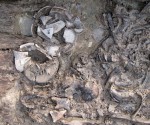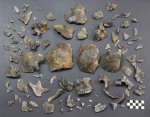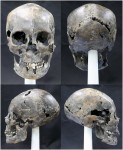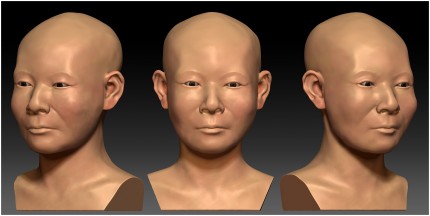 In late 2013, archaeologists excavating in advance of a driveway construction project near Gyeongju, a town in southeastern Korea that was the ancient capital of the Silla Kingdom, unearthed human skeletal remains. Found in a mokgwakmyo, a traditional wooden coffin, in a marshy area, the skeleton was complete and relatively well-preserved, albeit fragmented in places. Grave goods, including pottery and a wooden comb, were found inside the coffin that identify it as a Silla-era burial.
In late 2013, archaeologists excavating in advance of a driveway construction project near Gyeongju, a town in southeastern Korea that was the ancient capital of the Silla Kingdom, unearthed human skeletal remains. Found in a mokgwakmyo, a traditional wooden coffin, in a marshy area, the skeleton was complete and relatively well-preserved, albeit fragmented in places. Grave goods, including pottery and a wooden comb, were found inside the coffin that identify it as a Silla-era burial.
The Silla Kingdom started as a small city-state in 57 B.C. and ruled an increasingly large part of the Korean Peninsula until 935 A.D. Its thousand-year duration is one of the longest in the historical record, and two of its ruling dynasties — the Parks and the Kims — transcended the kingdom to become the most common family names in Korea today.
 Despite the Silla Kingdom’s long life and enormous influence on the history and modern culture of Korea, researchers have had few opportunities to study Silla bones at all, and never with multiple analytical technologies. Intact human remains from the Silla period are rare because Korea’s acidic soil and the cycles of hot/wet, cold/dry weather accelerate the decomposition of soft tissue and bone alike. A 4th-6th century grave discovered in 2009 contained unprecedented complete sets of human and horse armor, for example, but not a single human remain. The wooden coffin survived, as did a box with assorted grave goods. The bones had disintegrated. The discovery of a complete skeleton in 2013 gave scientists the chance to carry out anthropological analysis, extract mitochondrial DNA, run stable isotope tests and craniofacial analyses that led to a full facial reconstruction.
Despite the Silla Kingdom’s long life and enormous influence on the history and modern culture of Korea, researchers have had few opportunities to study Silla bones at all, and never with multiple analytical technologies. Intact human remains from the Silla period are rare because Korea’s acidic soil and the cycles of hot/wet, cold/dry weather accelerate the decomposition of soft tissue and bone alike. A 4th-6th century grave discovered in 2009 contained unprecedented complete sets of human and horse armor, for example, but not a single human remain. The wooden coffin survived, as did a box with assorted grave goods. The bones had disintegrated. The discovery of a complete skeleton in 2013 gave scientists the chance to carry out anthropological analysis, extract mitochondrial DNA, run stable isotope tests and craniofacial analyses that led to a full facial reconstruction.
 The person deceased was a woman between 35 and 39 years of age at time of death. The length of the femur indicated she was around 155 cm (five feet) tall. The mitrochondrial DNA results placed her haplogroup F1b1a, a haplogroup typical of East Asia but not the dominant group in living Koreans today. Stable isotope analysis found that her diet consisted mainly of foods in the C3 category (wheat, rice and potatoes) and was likely vegetarian.
The person deceased was a woman between 35 and 39 years of age at time of death. The length of the femur indicated she was around 155 cm (five feet) tall. The mitrochondrial DNA results placed her haplogroup F1b1a, a haplogroup typical of East Asia but not the dominant group in living Koreans today. Stable isotope analysis found that her diet consisted mainly of foods in the C3 category (wheat, rice and potatoes) and was likely vegetarian.
 Her skull was found broken in dozens of pieces. In order to help determine her gender and to create a facial reconstruction, archaeologists cleaned the fragments and dried them. Each piece was scanned and imported into 3D modelling software to figure out how the pieces fit together. Once the model was complete, the team then puzzled together the actual skull from the fragments.
Her skull was found broken in dozens of pieces. In order to help determine her gender and to create a facial reconstruction, archaeologists cleaned the fragments and dried them. Each piece was scanned and imported into 3D modelling software to figure out how the pieces fit together. Once the model was complete, the team then puzzled together the actual skull from the fragments.
Her skull was unusually long and narrow. This kind of head shape often seen in cases of intentional cranial deformation. It appears to be natural in her case. Intentionally deformed crania are flatter in the front and the bones of the side grow to compensate from the pressure of the deforming agent (usually a piece wood or tight bindings applied to infants when their skulls are still soft).
In the craniometric analysis, the major cranial indices were compared with the corresponding data derived from the subjects of modern Korean adults. The results showed that the skull has longer, narrower and lower cranium with a narrower facial bone and orbits than those from the modern Korean adults groups. The nasal aperture demonstrated an average width in the nasal index. In terms of appearance, it was assumed that the individual had horizontally long & vertically short head with inclined forehead from lateral view and narrower face from frontal view.
This dolichocephalic or long-headedness trait is rare in the population of Korea today. Koreans are more often brachycephalic, defined as the width of their skull being at least 80% of the length.
Here is the complete craniofacial reconstruction:

You can read the full study published in the journal PLOS ONE here.
The reference to potatoes must be an error–potatoes are a new world crop and were not growing in Asia at this time.
You’re right and the error was mine. I’ve clarified what the study authors meant, that her diet consisted mainly of foods in a certain category that includes potatoes although in this case of course she would not have eaten them. :thanks:
The reconstruction of that fractured skull is quite remarkable. I wonder if there is a cut to the right on the back of her head and a small impact resulting in a star-shaped fracture on the right side. Probably hard to tell, but thirty-five years of age is not that old.
The head shape might indeed be a case of intentional cranial deformation. For comparison, also from the 6th Century, a deformed skull from Thuringia, likewise with facial reconstruction.
PS: I read somewhere that the ‘pentagonal’ headshape -when looking at the skull from the back- is supposed to be ‘Polynesian’, and those peoples did in fact have the sweet potato, but probably not as early as the 6th Century. :yes:
A thousand years rivals the Byzantine Empire. And yet we know little about them.
Regarding the potatoes: Possibly it was eggplant, as it was cultivated early on in east Asia. It is a species of the nightshade as is the potato. Korea has several of it own varieties including purple, red, and white. The red is delicious if you can find it. I have only had it in Seoul.
Or possibly the category cited meant more like potato-like “root” veggies instead of something closely related to the potato species. In that case, possible candidates are Korean radishes (Mu), lotus root, burdock root, taro, doraji, ginseng and the many ginseng substitute/lookalikes, and many, many others in Korean cuisine even today. Korean radishes (which actually look kind of like potatoes) are sliced and diced thin as a key ingredient in Kimchi, the national dish of Korea. Forget the westernized all-cabbage version, get the real thing.
Or Korean Yams which are a superfood. Maybe that was the secret to Silla success?
“those peoples did in fact have the sweet potato”: assumed to have been collected by Easter Islanders who had touched on the South American continent. It must have happened while the Islanders still had trade links with the rest of Polynesia.
Remarkable navigators, your pre-historic Polynesians.
Have you seen one of their catamarans, built by two chaps with an axe ? – ‘Poly Nesia’ translates as ‘Many Islands’. Centuries of “nautical survival of the fittest” resulted in able seafarers: “The sweet potato has been radiocarbon-dated in the Cook Islands to 1000 AD, and current thinking is that it was brought to central Polynesia around 700 AD, possibly by Polynesians who had traveled to South America and back, and spread across Polynesia to Hawaii and New Zealand from there.”
This is one of the best books I’ve ever bought:
http://www.cambridge.org/us/academic/subjects/archaeology/archaeology-asia-sub-saharan-africa-and-pacific/prehistoric-exploration-and-colonisation-pacific?format=PB
In considering food possibilities, I doubt that the key is looking at what might resemble potatoes in appearance. “…her diet consisted mainly of foods in the C3 category (wheat, rice and potatoes) and was likely vegetarian.” The “C3” grouping is simply related to how a plant processes carbon, in this case creating compounds with 3 carbon atoms. This group includes a lot of starchy plants as rice, wheat, rye, barley, cassava, yams, and, yes, potatoes. It also includes algae and spinach. It all depends on what is growing where you live. A short explanation: https://en.wikipedia.org/wiki/C3_carbon_fixation
And another about how this fits into archaeology: http://archaeology.about.com/od/stableisotopes/qt/c3c4cam.htm
The skull looks like the skulls of Akhenaten and Tutankhamun.